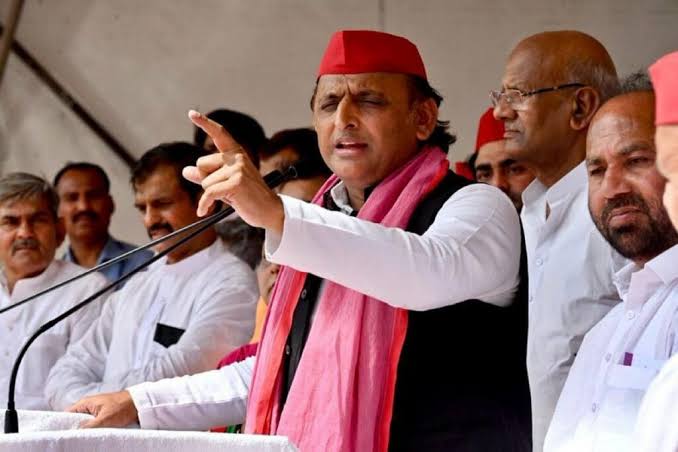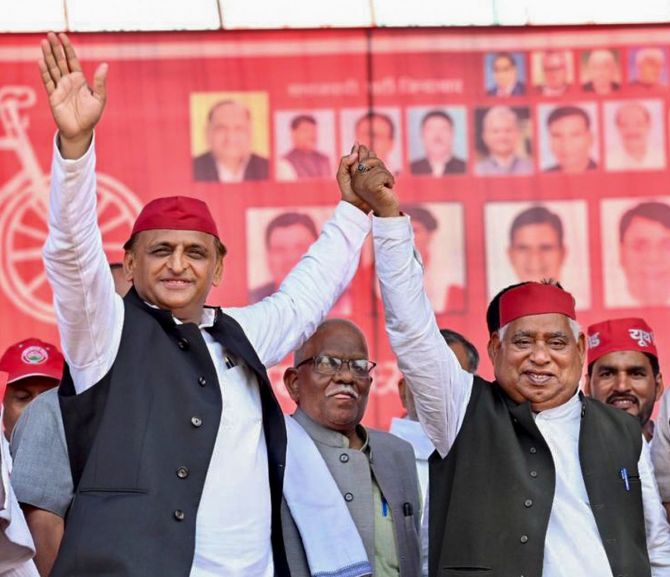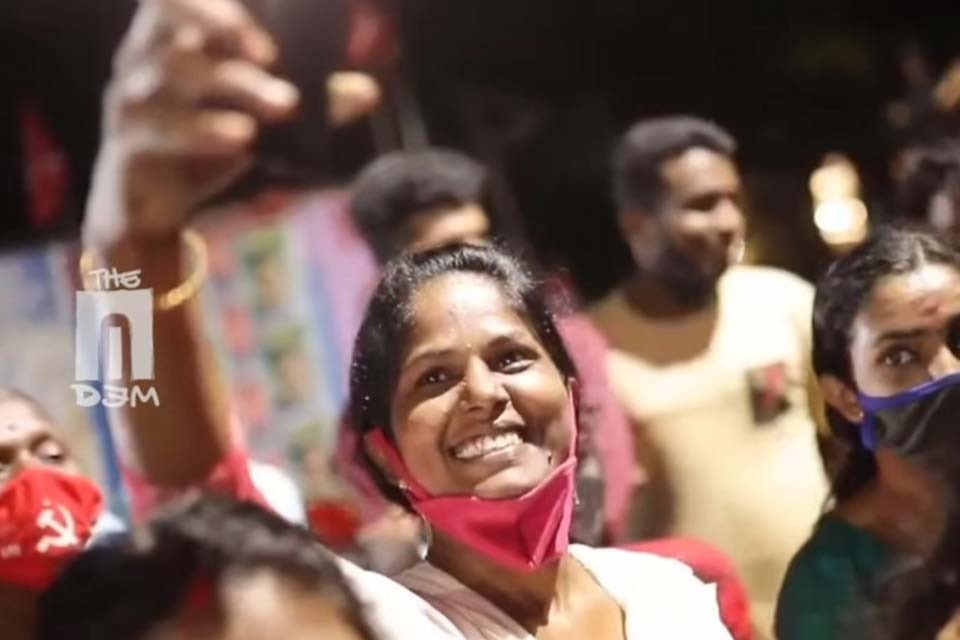
For many observers of the 2024 elections, the most shocking results are from Uttar Pradesh. The Samajwadi Party, (SP) led by Akhilesh Yadav, with 37 seats, has become the largest party in the most populous State of India. And that too, against all odds. It is a humongous win in a most uneven field, which was curated to the BJP’s advantage right from the very announcement of the election schedule.

Lopsided Resources
Samajwadi party received a paltry 14.05 crore through electoral bonds, compared to 6986.5 crore received by the BJP. The Trinamool Congress (TMC), which won West Bengal comprehensively, winning 29 seats, had received 1397 crores. The Dravida Munnetra Kazhakam (DMK) that swept Tamilnadu had received 656.5 crore. Both are heading their respective state governments. Additionally, both were fighting almost half the seats Samajwadi party was contesting.
Vindictive Administration
Multiple leaders of the Samajwadi party have been at the receiving end of the administration. Senior leader Azam Khan has been in and out of jail for different cases, all registered against him after 2017. Another MLA, Rafiq Ansari, was arrested on 26 May and sent to judicial custody for a case registered in 1995.

Swami Prasad Maurya had to reach the Supreme Court for relief against criminal proceedings for his remarks. Such was the trust in the fairness of the administration that sitting Ghazipur MP Afzal Ansari’s daughter also filed a nomination from Gazipur. A trial court in Ghazipur had convicted Afzal Ansari to a 4-year sentence in a Gangsters’ Act case. An appeal of the sentencing is ongoing in the High Court of Allahabad.
Departure of Erstwhile Associates
In 2022, the Samajwadi Party had stitched alliances with sub-divisional political parties with localized influence such as the O.P Rajbhar-led Suheldev Bhartiya Samaj Party, which claimed to represent the Rajbhar – one of the other backward castes -community in eastern UP region, commonly referred to as Purvanchal. Yet another ally of SP in 2022 was Apna Dal (Kamerawadi), led by Pallavi Patel, who defeated BJP Deputy CM Keshav Prasad Maurya in the 2022 assembly election. Both the series deserted the SP before the Lok Sabha election. Om Prakash Rajbhar chose to go back to the BJP in 2023 and later became a minister. Apna Dal(K), led by Pallavi Patel, quit the INDIA alliance a few weeks before the first phase of the voting, partnering with AIMIM to fight elections in Uttar Pradesh.

In the Rajya Sabha elections in February 2024, just two months before the start of the Lok Sabha poll, 7 Samajwadi Party MLAs cross-voted for the BJP candidate. One of the 7 MLAs, Manoj Pandey, was the party’s chief whip in the state assembly, Pandey formally joined the BJP in May.
Voting Irregularities Complaints
Different phases of elections in Uttar Pradesh had complaints of voter suppression, especially among Muslim voters. In the first phase, Harendra Malik, contesting from Muzaffarnagar, alleged booth capturing and filed a complaint with the Election Commission of India. Iqra Hasan, contesting from Kairana, complained of slow voting in her constituency. In Rampur, the SP candidate complained about Police turning away Muslim voters.

In the second phase, Muslim voters in Mathura complained of missing names. In the 3rd phase, in Sambhal, there were reports of Police beating Muslim voters and confiscating their identity cards. Sambhal is a traditional stronghold of the Samajwadi party. Even as all this was being reported, a boy’s video went viral, seen voting eight times in an Electronic Voting Machine on the BJP’s symbol, the Lotus. The administration later filed an FIR on this incident, which happened in Etah. Etah went to the polls in the fourth phase. In the 5th phase of polling, 150 complaints out of 250 were related to voter suppression.
Victory across All Regions
Despite all these challenges, the Samajwadi party won impressively across all regions. It won 37 seats. Its ally in the INDIA, Congress won 6 seats. The INDIA alliance lost 20 seats by less than 50,000 votes. Narendra Modi could only manage a margin of around 1.5 lakh votes. BJP’s special slogan in Varanasi was “Abki Baar 10 lakh paar” (win by 10 lakh margin). He had won the 2019 LS elections by nearly 5 lakh votes. Rajnath Singh, Defence minister in the Modi government and a senior BJP leader, who had won the 2019 LS elections with a margin of 3.5 lakh votes, saw his winning margin coming down to 1.35 lakh votes.
Braving the Temple Politics
Uttar Pradesh has been the laboratory of BJP’s temple politics. The social, cultural and political sway of the temple towns of Kashi, Ayodhya and Mathura cover the population of the entire state from one end to another. These cities are sites of the temples that are claimed to have been desecrated during Aurangzeb’s reign. Babri Masjid, which many Hindus believe was built after breaking down a Ram Temple in Ayodhya, was demolished in 1992. Several BJP leaders were named as accused in the demolition case.

In 2019, however, the Supreme Court of India, in a unanimous decision, ruled in favour of the people supporting the temple and handed over the disputed site for building a temple. On 22 January 2024, a new temple was inaugurated at the site, where PM Modi took center stage in the religious rituals. BJP and its supporters castigated anyone who disagreed with this brazen violation of secular ideals of the Indian Constitution. They were also branded as anti-Hindu. Mainstream media, including major Hindi newspapers, shunned neutrality and sided with the BJP. Despite this, Akhilesh Yadav remained steadfast to his secular values. He didn’t attend the inauguration of the Ram temple. By 2024, he had already lost four successive elections, yet decidedly stuck to secularist principles, instead of riding with the popular mood.
Rejecting the Caste Prism
The primacy of caste identity is seen as a matter of routine by many observers and even practitioners in Uttar Pradesh politics. The BJP had reaped major electoral dividends in the 2017, 2019, and 2022, elections by resolutely advancing Hindutva temple-politics. In the process, the saffron party stitched together a broad alliance of various sub-castes of the Hindu community. In the 2022 assembly elections, Akhilesh Yadav tried a strategy on similar lines, by bringing together a number of smaller parties with a pronounced sub-caste tilt. But this effort too did not succeed and the SP leader could not comprehensively win the election, though his party’s vote and seat share increased significantly.
In 2024, he fought the election around livelihood issues, forcefully articulating the job crisis, unemployment, paper leaks in Government recruitment examinations, and stray animal issues affecting farmers. This campaign created such a huge popular resonance that his election rallies were marked by the presence of massive, impassioned crowds that braved the sweltering heat of the peak summer afternoons. He did not ally with any other sub-regional caste outfits and confined his alliance to the Congress. Instead, he raised the pitch of PDA-Pichda (Backward), Dalit (Scheduled Caste), and Alpashankhyak (Minority), and followed it up with enhanced social inclusion in the selection of candidates.

A striking case in point is the Faizabad constituency, which also houses the temple town of Ayodhya, where the Ram Mandir is situated. Here, the Samajwadi party gave ticket to Awadhesh Prasad, a Dalit, to fight on a general category seat. It was indeed a brave and unusual political practice, with rare precedence. Awadhesh Prasad won the seat, defeating two-time BJP MP Lallu Singh.
No Political Consultants
Since 2014, when Narendra Modi hired the services of external political consultants to run his electoral campaign, it has been a widely adopted practice of political parties, a norm of sorts of new-age politics. In 2019, 60,000 crores were spent on elections. At 80 INR to USD conversion rate, it’s 7.5 billion USD. In the 2020 Presidential elections in the USA, election expenditure was around 6.6 billion USD. US GDP is almost 8 times of India’s GDP. Akhilesh Yadav ran a frugal campaign and chose not to outsource his political campaign to any external consultant. Instead, he relied on the traditional methods of using the party machinery to communicate with the people. Lack of funds may have been a factor in this decision. But, he proved that an election can be decisively won without spending huge amounts on political consultancies. In doing this, he has shown a new path to other parties.

In this astounding victory of the Samajwadi party, 50-year-old Akhilesh Yadav has emerged as the new star. In a communally polarized environment, Akhilesh Yadav’s steadfast commitment to secularism and focus on livelihood issues resonated with the people. He departed from his 2022 strategy of aligning with sub-caste politicians who were street hawkers of their community votes and this bold step paid electoral dividends. By running a relatively inexpensive campaign, he has proved that elections can be fought with less money. With a decisive public mandate, he may rewrite the politics of Uttar Pradesh for the next decade.

Watch The AIDEM interview with Akhilesh Yadav during the 2024 Election campaign here.












Thanks for the in-depth analysis of the UP election